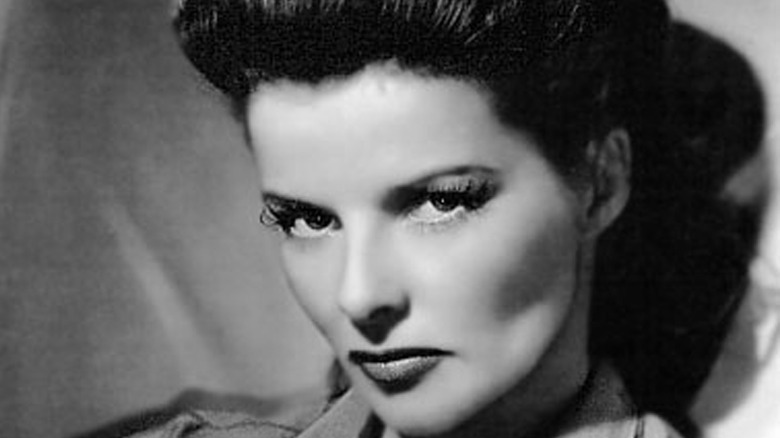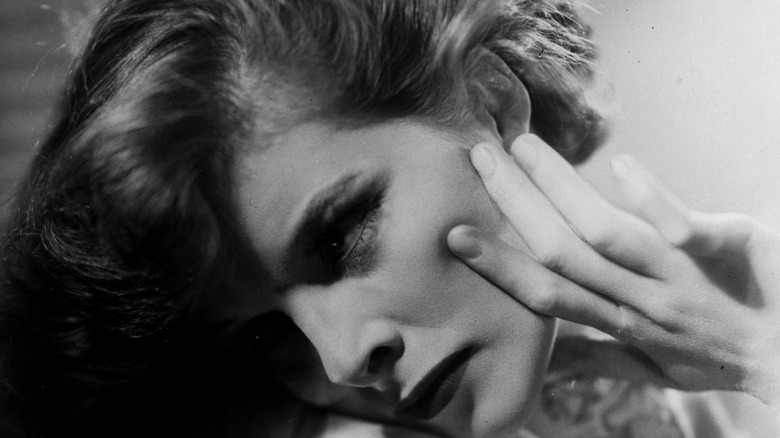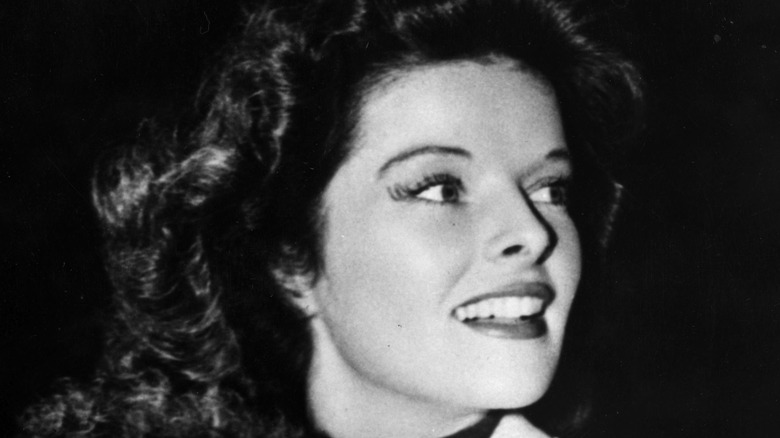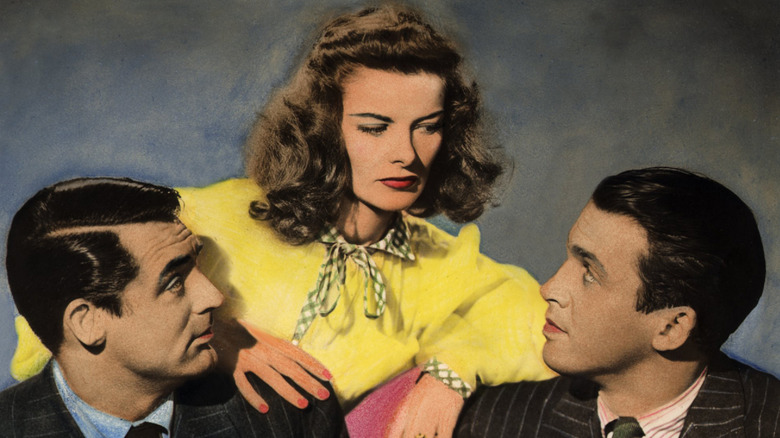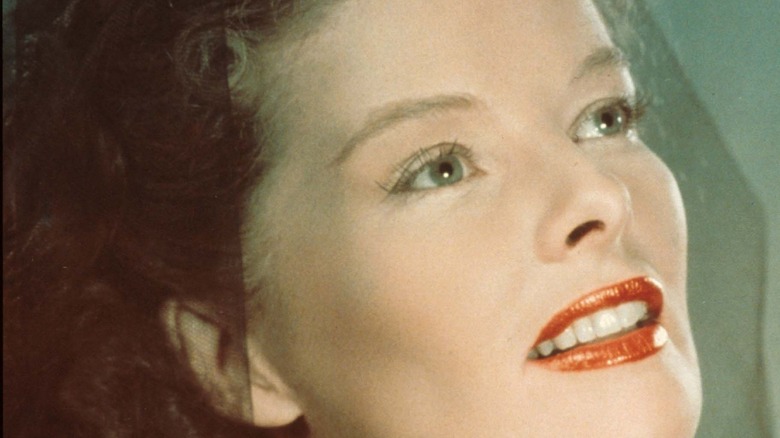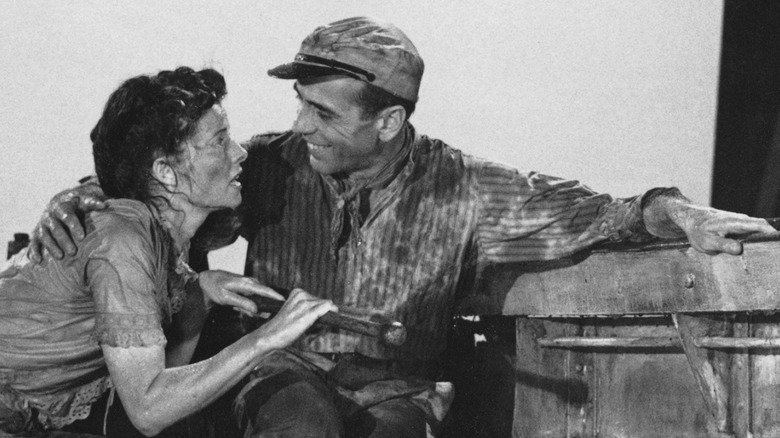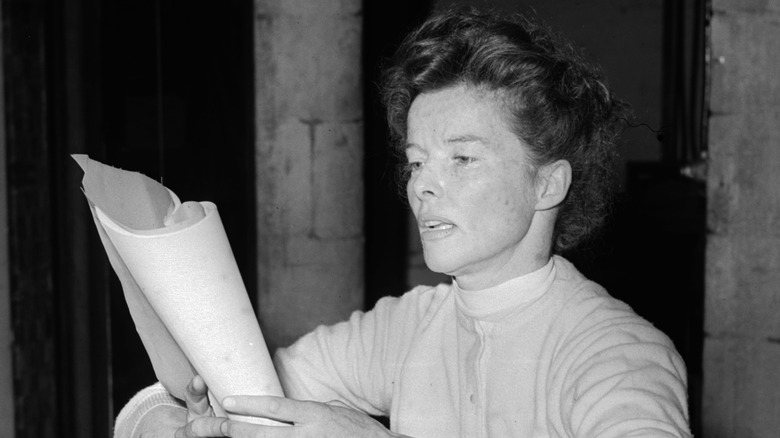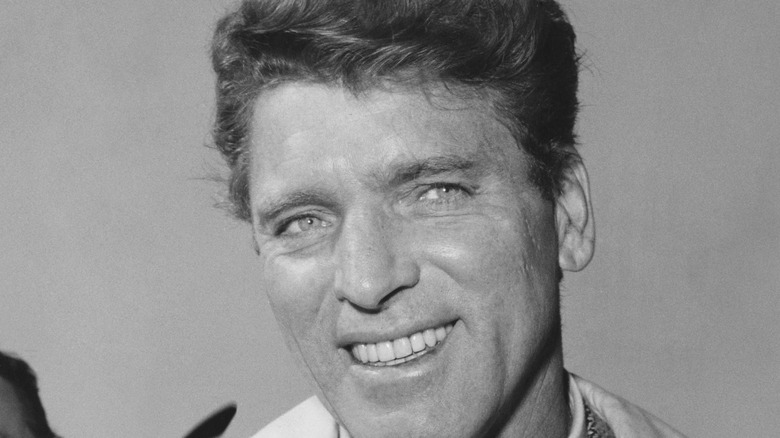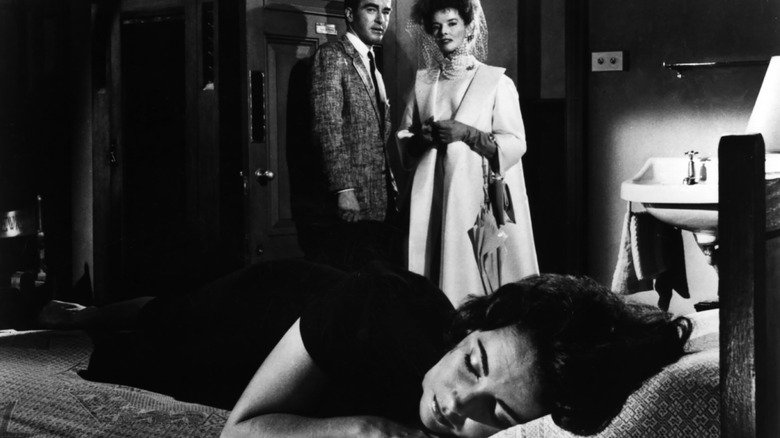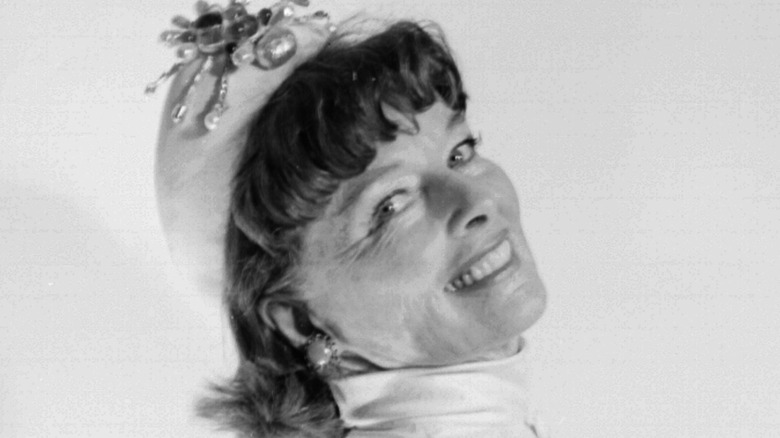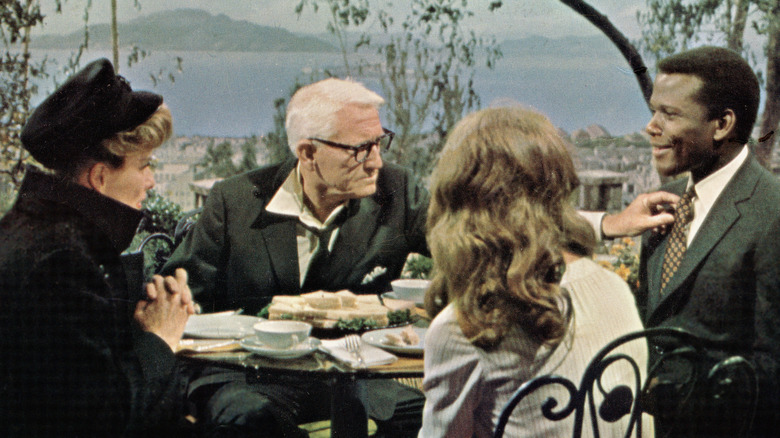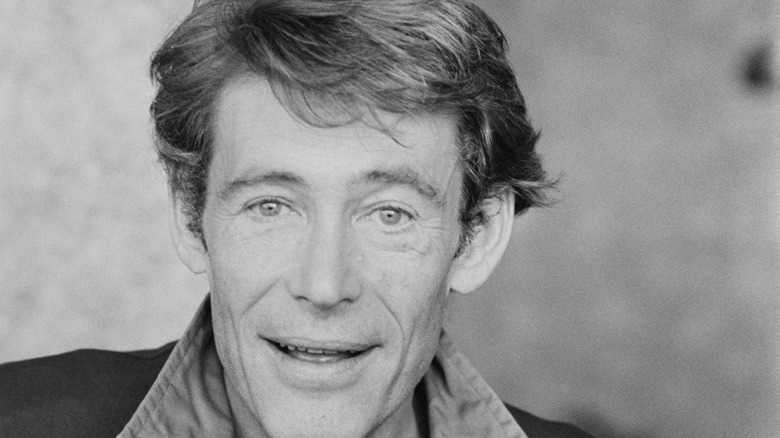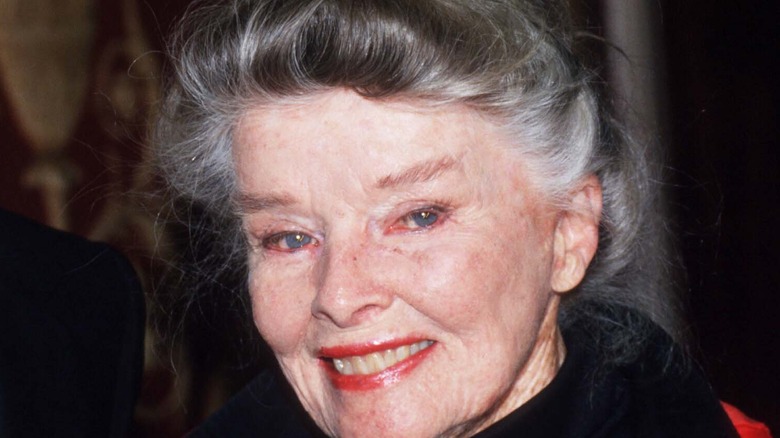Every Film Katharine Hepburn Received An Oscar Nomination For
Few figures in Hollywood history have had the screen presence or prolific career of Katharine Hepburn. She was, by all accounts, an anomaly, someone who Britannica describes as an "unlikely star." Hepburn was commanding and quirky, as well as extremely assertive and independent during a time when that was not the norm for women in Hollywood. As explained by Biography, she wasn't interested in playing by Hollywood's traditional rules for women: She didn't always dress up or wear makeup while out, she dressed unconventionally, and she shunned media when at all possible.
By Hepburn's own account, she also had no issue clashing with co-stars or directors when she felt it was necessary. Yet, she was beloved by her directors and co-stars over her six decades in Hollywood, with few who had negative words to say about her. The Academy of Motion Picture Arts and Sciences clearly admired her as well, nominating her for a staggering 12 Oscars, tied with Jack Nicholson and surpassed only by Meryl Streep (per Insider).
Morning Glory (1933)
Katharine Hepburn was primarily a Broadway actress before she ended up in Hollywood. As described by Britannica, after graduating from Bryn Mawr College in 1928, she began acting on stage to positive reviews. According to her memoir "Me: Stories of My Life," she didn't know New York City very well, nor did she know many people living there, but she was doing what she loved most: acting.
In 1932, she got her break into Hollywood with RKO Radio Pictures, making her debut in "A Bill of Divorcement." The studio offered her $500 per week, but she countered with $1,500, a figure unfathomable for an unknown actress, according to the Saturday Evening Post. The studio met her at $1,250 and the film went into production.
By 1933, Hepburn had completed her third Hollywood film, "Morning Glory," about an aspiring actress named Eva Lovelace who heads to New York to pursue her dreams of appearing on Broadway (per Turner Classic Movies). Directed by Lowell Sherman and co-starring the swashbuckling former silent film star Douglas Fairbanks (of "Robin Hood" fame), the film was based on a play by future Pulitzer winner Zoe Akins. As The New York Times wrote in their original review of the film, the story was not particularly original, but Hepburn's character was a "captivating personality." Ultimately, Hepburn was nominated and won her first Oscar for the role, solidifying her status as a promising if unconventional new Hollywood star.
Alice Adams (1935)
After winning her first Oscar, Katharine Hepburn's profile skyrocketed, although that didn't mean instant success for her every endeavor. According to Britannica, she attempted a return to Broadway as her contract permitted, but the show flopped. So instead, she continued her Hollywood career, completing four more films that weren't particularly huge hits, including an adaptation of "Little Women" in which she played Josephine. Then, in 1935, she landed what would become her second Oscar-nominated role, playing the titular character in director George Stevens' "Alice Adams."
The film, based on the Booth Tarkington novel of the same name, follows a woman from a working-class family who has upper-class aspirations. Naturally, Hepburn's character Alice falls head-over-heels for a charming, wealthy womanizer and an unlikely love story ensues (per Turner Classic Movies). She and director Stevens sometimes clashed on set, even verbally on occasion, over how much vulnerability and sensitivity she should show in certain scenes, according to biographer Anne Edwards.
Regardless of their differences in opinion, their collaboration worked. The New York Times praised this as one of her finest performances thus far and noted it brought her status back to a "high place after faltering in several bad pictures." Ultimately, the Oscar would go to Bette Davis for her dark and dramatic role in "Dangerous."
The Philadelphia Story (1940)
Over the next few years, despite her successes, Katharine Hepburn became known in the industry as "box office poison" (per Britannica). Even after the financial success of screwball comedies "Bringing Up Baby" and "Holiday," co-starring Cary Grant, the reputation of her other box office failures continued to haunt her career. So, Hepburn returned to the stage again, this time for Philip Barry's 1938 play "The Philadelphia Story."
It was a hit and Hepburn subsequently decided to take the play to Hollywood. According to biographer Anne Edwards in "Katharine Hepburn: A Remarkable Woman," Hepburn originally wanted Spencer Tracy for the role of her character's ex-husband, but the studio pushed back (partially due to his problems with alcohol). Ultimately, Cary Grant was picked for the role.
"The Philadelphia Story" follows socialite Tracy Lord as she prepares to remarry while her still head-over-heels ex-husband (Grant) and a tabloid reporter (James Stewart) cause hijinks along the way. In their original review, Variety described Hepburn's performance glowingly, saying "it's [her] picture just as it was her show."
While the film won the Oscar for its screenplay and James Stewart won for best actor, Hepburn was beaten out for best actress by Ginger Rogers. However, as the Criterion Collection explains, this was the film that "revitalized" Katharine Hepburn's career and made her the time period's "most iconic leading lady." With over 100 reviews on Rotten Tomatoes, it still holds a coveted 100% on the Tomatometer today.
Woman of the Year (1942)
In 1942, Katharine Hepburn followed up "The Philadelphia Story" with "Woman of the Year," for which she would earn her fourth Oscar nomination. Reteaming with "Alice Adams" director George Stevens, the film tells the story of a serious political writer, played by Hepburn, and her unlikely romance with a sportswriter, played by Spencer Tracy (who had been passed over for her previous film), in what would be the first of their nine films together (per Turner Classic Movies).
According to Britannica, the film was also the start of a secret, decades-long relationship between the two stars. Hepburn opened up about the relationship later in life, even in her own memoir, where she discussed how the two kept it a secret, the pain it caused Tracy's wife (who remained married to him), and their ability to avoid the press. In Anne Edwards' Hepburn biography, Edwards describes how alcoholism took a toll on Tracy's health and fueled his depression, which made him temperamental and impatient on set. Despite this and the duo's inherent differences in personality, Hepburn and Tracy clicked on and off camera.
As for the film, Criterion Collection describes "Woman of the Year" as "dazzling" and "funny," while also a realistic portrayal of a marriage between two very different people with two very different perspectives. In their original review, The New York Times amusingly described the film to be as "warming as a Manhattan cocktail" while still being "as juicy as a porterhouse steak."
The African Queen (1951)
In the ensuing years, Katharine Hepburn kept working steadily, even returning to the stage on a few occasions. In 1951, she was cast in "The African Queen" with director John Huston, who had made a name for himself with gritty thrillers like "The Maltese Falcon" and "The Treasure of Sierra Madre."
"The African Queen" teamed Hepburn with Huston's usual leading man, Humphrey Bogart, who played a riverboat captain assisting Hepburn's character in a daring escape from German troops during World War I. According to Britannica, the shoot was challenging, since they filmed on location in Congo, Uganda, and Turkey. Anne Edwards explains in her Hepburn biography how the actors were challenged by torrential rainstorms, countless mosquitoes, sickness, and the tensions of being in close quarters for an extended period of time. However, the film also demonstrated Huston's understanding of the chemistry between his two leads, who he often encouraged to improvise dialogue.
The film was a triumph. Not only did it snag Hepburn another Oscar nomination, but it also earned Bogart his only Oscar win (along with nominations for Huston and the screenwriter). As described by Roger Ebert in his essay on the film, this was not an inevitable hit, as it was a time in which many alleged that both Hepburn and Bogart were past their primes. The audiences preferred new actors like Marlon Brando and Vivien Leigh, who had starred in the hit "A Streetcar Named Desire" from the previous year.
Summertime (1955)
In the four years following "The African Queen," Katharine Hepburn performed in only one feature film. Then, in 1955, she joined "Summertime," directed by David Lean. At this point in Lean's career, he'd already had considerable success behind the camera, directing films such as "Great Expectations" and "Oliver Twist," although he had not yet become known for his later critically-acclaimed films such as "The Bridge on River Kwai" and "Lawrence of Arabia" (per Britannica).
Lean's "Summertime" follows Hepburn's character, a middle-aged, unmarried American teacher, as she travels to Venice, Italy, and falls into a romantic summer fling with a married man (per Criterion). In a 2022 review for Collider, Julia Harari describes the film as one about independence but also isolation, with Hepburn's character running away from "nothingness" for "somethingness."
Whatever the case, it resonated with critics and audiences. The New York Times praised her performance as "clever and amusing," but also capturing the character's "wistful frustration." It was a box office hit also and received two Oscar nominations, including another for Hepburn. In a recent review for the film's Criterion Blu-ray release, Slate Magazine called the film "gorgeous" and "immaculate," showing it holds up even today.
The Rainmaker (1956)
Hot off her sixth Oscar nomination, Katharine Hepburn took on a role that would ultimately snag her a seventh. In 1956's "The Rainmaker," Hepburn stars alongside Burt Lancaster, who earned his first Oscar nod only a few years earlier for his 1953 movie "From Here to Eternity" (per Britannica). "The Rainmaker" is a unique film. The American Film Institute describes it as being about a grifting conman (Lancaster) who goes from town to town during a widespread drought promoting himself as a "rainmaker," someone who can bring rain to the community if people only believe. The film follows Lancaster's character in his journey to a new town, where he gets mixed up with the family of Hepburn's character. As explained in Andrew Britton's "Katharine Hepburn: Star as Feminist," Hepburn's character tries to learn to trust the charismatic conman, despite his livelihood being a lie, eventually falling in love with him.
A 1957 review by Clyde Gilmour describes the movie as "hammy and stagey in spots," but ultimately well done. The New York Times reviewed the film too, agreeing it was perhaps a bit sentimental overall, but humorous. The Academy agreed enough to give Hepburn one of the film's two Oscar nominations.
Suddenly, Last Summer (1959)
Katharine Hepburn would appear in two more comedies before joining the much more dramatic and dark "Suddenly, Last Summer." The film, which co-starred Elizabeth Taylor and Montgomery Clift, was adapted from a Tennessee Williams play and dealt with serious issues including mental health, lobotomies, sex, and even cannibalism (per Britannica). Gore Vidal, who wrote the screenplay, was already an acclaimed novelist at the time. His writing often surprised and shocked audiences with perspectives that were deemed controversial and inappropriate at the time, according to Britannica.
"Suddenly, Last Summer" was also a rare film in which Hepburn played the villain, a wealthy woman attempting to use her prestige and influence over a doctor to have her niece lobotomized for nefarious purposes. Needless to say, critics didn't love it. The New York Times review called the film pretentious and argued that many actors were over-acting. The Chicago Reader alleged that the film "flirts with camp." Despite this, it snagged Hepburn another Oscar nomination, as well as a nod for co-star Elizabeth Taylor.
Long Day's Journey Into Night (1962)
By the 1960s, Katharine Hepburn had begun to get even pickier with the roles she chose to play, opting to do one film every two to three years rather than one or more per year. In 1962, she joined the cast of Sidney Lumet's "Long Day's Journey Into Night" with Ralph Richardson and Jason Robards. The film is about a young aspiring writer with severe family issues (per Turner Classic Movies). Lumet had already been very successful with 1957's "12 Angry Men," according to Britannica (although he had yet to film later classics such as "Serpico," "Dog Day Afternoon," and "Network").
"Long Day's Journey Into Night" was based on a 1956 autobiographical play from Nobel Prize-winning writer Eugene O'Neill. According to biographer Anne Edwards, Lumet as well as the cast all took reduced salaries in order to ensure financing for the film's production. The story is about a young writer (based on O'Neill and played by Dean Stockwell) who struggles with a difficult homelife that includes an alcoholic father (played by Richardson), a mother dealing with addiction (played by Hepburn), and a black sheep brother (played by Robards).
The New York Times review called the film "stunning" and described Hepburn's performance as "vibrant" and revealing a "hot and tragic truth." It received great reviews overall and an excellent reception at the Cannes Film Festival, although Hepburn was the only Oscar nomination. Anne Bancroft won for her performance in "The Miracle Worker."
Guess Who's Coming to Dinner (1967)
After taking nearly five years off from Hollywood (as she helped Spencer Tracy through illness, Britannica explains), Katharine Hepburn returned in "Guess Who's Coming to Dinner," directed by Stanley Kramer and co-starring Tracy, Sidney Poitier, and Hepburn's own real-life niece Katharine Houghton. Sadly, it would be the ninth and final time Hepburn and Tracy worked together, as he died shortly after filming at age 67 (per Los Angeles Times).
The 1960s were marked by the Civil Rights Movement, so it's no surprise Hollywood tackled issues of race — in this case, using humor to demonstrate the importance of tolerance in a movie about interracial marriage. The film, per Britannica, is about two parents (Hepburn and Tracy) whose daughter (Houghton) is revealed to be engaged to a Black doctor (Poitier).
Roger Ebert acknowledged the film's flaws in his review, but said it was still a "magnificent piece of entertainment" that would make a viewer both laugh and cry. Variety's original review was also positive and said the film "must be seen to be believed." Ultimately, "Guess Who's Coming to Dinner" was a hit and received 10 Oscar nominations, which led to Hepburn winning her second statue.
If anyone thought she would buck her trend of skipping the awards show this time to receive it, though, they were sadly mistaken. As explained in The Hollywood Reporter, Hepburn had yet to attend the Academy Awards ceremony, because to her, the prize was simply her work.
The Lion in Winter (1968)
Following the critical and commercial success of "Guess Who's Coming to Dinner" was going to be difficult, so Katharine Hepburn did what many performers do after winning a prestigious award: She tried something completely different. Her next film was "The Lion in Winter," a Middle Ages period piece about King Henry II (played by Peter O'Toole, who had also portrayed the character in 1964's "Becket") and Queen Eleanor of Aquitaine (Hepburn) trying to decide upon an heir to the throne (per Turner Classic Movies).
Like Hepburn, O'Toole was already a massive star, having crashed onto the Hollywood scene as protagonist T.E. Lawrence in David Lean's 1962 epic "Lawrence of Arabia" (per Britannica). But "The Lion in Winter" was also a big break for some actors, marking the first film appearance of British stars Anthony Hopkins and Timothy Dalton.
"One of the joys which movies provide too rarely is the opportunity to see a literate script handled intelligently," Roger Ebert wrote in his review of "The Lion in the Winter," adding that Hepburn was "magnificent" and he couldn't imagine anyone else in the role. According to Cineaste Magazine, it was O'Toole himself who insisted on casting Hepburn after deciding that the film was going to be his next project. It paid off. The film was nominated for seven Oscars and won three — including one for Hepburn, making it her third Oscar win.
On Golden Pond (1981)
After her Oscar win for "The Lion in the Winter" (her 11th nomination), Katharine Hepburn finally attended her first Academy Awards ceremony — but it wasn't for herself. As described by Today, she attended the ceremony in 1974 to present an award to her producer and friend Lawrence Weingarten. In her own career, she continued to act in a movie once every two or three years.
In 1982, she earned her 12th and final Oscar nomination for "On Golden Pond." She joined Henry Fonda to star in the film, an adaptation of a popular play about an aging couple and their rocky and complicated relationship with their daughter, played by Fonda's real-life daughter Jane Fonda (per Turner Classic Movies). The critics loved it. The New York Times praised the chemistry between Hepburn and Fonda, saying Fonda was her best co-star since Bogart and Tracy. On top of being both a critical and financial success, Fonda won his first and only Oscar for the film, while Hepburn won her record-breaking fourth best actress statue — and no, once again, she did not attend the ceremony.
Hepburn would appear in a few more films over the following decade before being honored by the Kennedy Center in 1990, according to Britannica. In 1999, the American Film Institute named her the greatest American actress of all time. Hepburn died at her Connecticut home on June 29, 2003, at age 96.
